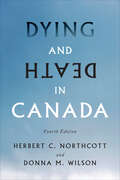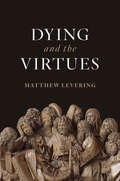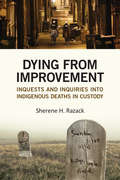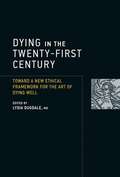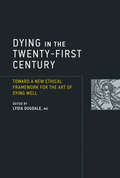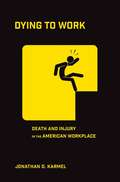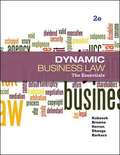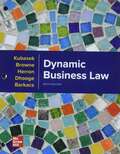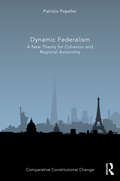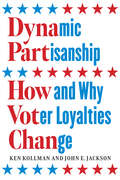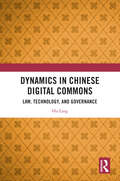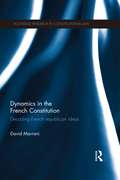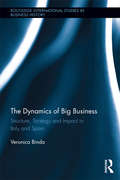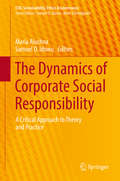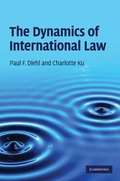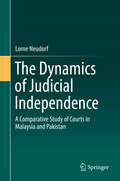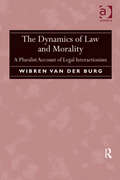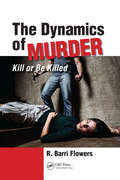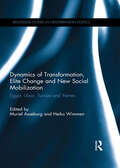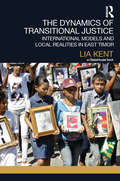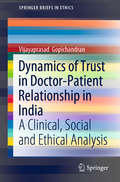- Table View
- List View
Dying and Death in Canada, Fourth Edition
by Donna Wilson Herbert NorthcottDying and Death in Canada provides a comprehensive, up-to-date examination of dying, death, and bereavement from a Canadian perspective. The fourth edition covers current issues and recent developments in the field, such as the implementation of Medical Assistance in Dying (MAID) and the implications of the COVID-19 pandemic. New topics include death doulas, death tourism, psychogenic death, bonds between the living and the dead, mass death events, and cultural diversity, sensitivity, and competence. This edition combines current research and language used to destigmatize conversations surrounding suicide, while new case studies offer personal accounts from doctors, nurses, and family members of the deceased. Exploring the significance of end-of-life experiences, Dying and Death in Canada shows that how we live influences how we die, and the society and culture in which we live has a profound effect on how we behave when confronted with dying and death.
Dying and the Virtues
by Matthew LeveringIn this rich book Matthew Levering explores nine key virtues that we need to die (and live) well: love, hope, faith, penitence, gratitude, solidarity, humility, surrender, and courage.Retrieving and engaging a variety of biblical, theological, historical, and medical resources, Levering journeys through the various stages and challenges of the dying process, beginning with the fear of annihilation and continuing through repentance and gratitude, suffering and hope, before arriving finally at the courage needed to say goodbye to one&’s familiar world. Grounded in careful readings of Scripture, the theological tradition, and contemporary culture, Dying and the Virtues comprehensively and beautifully shows how these nine virtues effectively unite us with God, the One who alone can conquer death.
Dying from Improvement
by Sherene RazackNo matter where in Canada they occur, inquiries and inquests into untimely Indigenous deaths in state custody often tell the same story. Repeating details of fatty livers, mental illness, alcoholic belligerence, and a mysterious incapacity to cope with modern life, the legal proceedings declare that there are no villains here, only inevitable casualties of Indigenous life.But what about a sixty-seven-year-old man who dies in a hospital in police custody with a large, visible, purple boot print on his chest? Or a barely conscious, alcoholic older man, dropped off by police in a dark alley on a cold Vancouver night? Or Saskatoon's infamous and lethal starlight tours, whose victims were left on the outskirts of town in sub-zero temperatures? How do we account for the repeated failure to care evident in so many cases of Indigenous deaths in custody?In Dying from Improvement, Sherene H. Razack argues that, amidst systematic state violence against Indigenous people, inquiries and inquests serve to obscure the violence of ongoing settler colonialism under the guise of benevolent concern. They tell settler society that it is caring, compassionate, and engaged in improving the lives of Indigenous people - even as the incarceration rate of Indigenous men and women increases and the number of those who die in custody rises.Razack's powerful critique of the Canadian settler state and its legal system speaks to many of today's most pressing issues of social justice: the treatment of Indigenous people, the unparalleled authority of the police and the justice system, and their systematic inhumanity towards those whose lives they perceive as insignificant.
Dying in Prison: Deaths from Natural Causes in Prison Culture, Regimes and Relationships (Palgrave Studies in Prisons and Penology)
by Carol RobinsonThis book uses empirical data gathered using ethnographic methods in two contrasting prisons to provide a rare insight into death and dying in prisons in the UK. The majority of deaths in prison custody in England and Wales result from natural causes, yet the experiences of people dying in prison and the impact of these deaths on the wider prison are under-researched areas. It provides a novel insight into the impact of deaths from natural causes on the prison as an institution and challenges existing work juxtaposing occupational philosophies of ‘care’ and ‘control’. It also identifies how end of life care is provided in prisons and the impact this has on culture and relationships shows how deaths from natural causes in prison custody ‘soften’ prison regimes, culture and relationships. It speaks to an international audience by drawing on the global literature including from the US.
Dying in the Twenty-First Century
by Lydia DugdaleMost of us are generally ill-equipped for dying. Today, we neither see death nor prepare for it. But this has not always been the case. In the early fifteenth century, the Roman Catholic Church published the Ars moriendi texts, which established prayers and practices for an art of dying. In the twenty-first century, physicians rely on procedures and protocols for the efficient management of hospitalized patients. How can we recapture an art of dying that can facilitate our dying well? In this book, physicians, philosophers, and theologians attempt to articulate a bioethical framework for dying well in a secularized, diverse society. Contributors discuss such topics as the acceptance of human finitude; the role of hospice and palliative medicine; spiritual preparation for death; and the relationship between community, and individual autonomy. They also consider special cases, including children, elderly patients with dementia, and death in the early years of the AIDS epidemic, when doctors could do little more than accompany their patients in humble solidarity.These chapters make the case for a robust bioethics -- one that could foster both the contemplation of finitude and the cultivation of community that would be necessary for a contemporary art of dying well. ContributorsJeffrey P. Bishop, Lisa Sowle Cahill, Daniel Callahan, Farr A. Curlin, Lydia S. Dugdale, Michelle Harrington, John Lantos, Stephen R. Latham, M. Therese Lysaught, Autumn Alcott Ridenour, Peter A. Selwyn, Daniel Sulmasy
Dying in the Twenty-First Century: Toward a New Ethical Framework for the Art of Dying Well (Basic Bioethics)
by Lydia DugdalePhysicians, philosophers, and theologians consider how to address death and dying for a diverse population in a secularized century.Most of us are generally ill-equipped for dying. Today, we neither see death nor prepare for it. But this has not always been the case. In the early fifteenth century, the Roman Catholic Church published the Ars moriendi texts, which established prayers and practices for an art of dying. In the twenty-first century, physicians rely on procedures and protocols for the efficient management of hospitalized patients. How can we recapture an art of dying that can facilitate our dying well? In this book, physicians, philosophers, and theologians attempt to articulate a bioethical framework for dying well in a secularized, diverse society.Contributors discuss such topics as the acceptance of human finitude; the role of hospice and palliative medicine; spiritual preparation for death; and the relationship between community, and individual autonomy. They also consider special cases, including children, elderly patients with dementia, and death in the early years of the AIDS epidemic, when doctors could do little more than accompany their patients in humble solidarity.These chapters make the case for a robust bioethics—one that could foster both the contemplation of finitude and the cultivation of community that would be necessary for a contemporary art of dying well.ContributorsJeffrey P. Bishop, Lisa Sowle Cahill, Daniel Callahan, Farr A. Curlin, Lydia S. Dugdale, Michelle Harrington, John Lantos, Stephen R. Latham, M. Therese Lysaught, Autumn Alcott Ridenour, Peter A. Selwyn, Daniel Sulmasy
Dying to Work: Death and Injury in the American Workplace
by Jonathan D. KarmelIn Dying to Work, Jonathan Karmel raises our awareness of unsafe working conditions with accounts of workers who were needlessly injured or killed on the job. Based on heart-wrenching interviews Karmel conducted with injured workers and surviving family members across the country, the stories in this book are introduced in a way that helps place them in a historical and political context and represent a wide survey of the American workplace, including, among others, warehouse workers, grocery store clerks, hotel housekeepers, and river dredgers.Karmel’s examples are portraits of the lives and dreams cut short and reports of the workplace incidents that tragically changed the lives of everyone around them. Dying to Work includes incidents from industries and jobs that we do not commonly associate with injuries and fatalities and highlights the risks faced by workers who are hidden in plain view all around us. While exposing the failure of safety laws that leave millions of workers without compensation and employers without any meaningful incentive to protect their workers, Karmel offers the reader some hope in the form of policy suggestions that may make American workers safer and employers more accountable. This is a book for anyone interested in issues of worker health and safety, and it will also serve as the cornerstone for courses in public policy, community health, labor studies, business ethics, regulation and safety, and occupational and environmental health policy.
Dynamic Business Law: The Essentials
by Nancy Kubasek Linda Barkacs Lucien Dhooge M. Browne Daniel HerronDynamic Business Law: The Essentials is appropriate for the one-semester Business Law course. It contains the basics of business law but does not get bogged down in the kind of details that are more appropriate in an upper-level law class. The text provides an examination of the basic questions, concepts, and legal rules of business law. Emphasis on the BUSINESS in business law. Dynamic Business Law: The Essentials emphasizes the tie of legal issues back to the core business curriculum. This will help both students and faculty. Faculty need to know how this is integrated as they are constantly 'defending' the inclusion of this course in the business curriculum. And students need to understand how the concepts tie to their future business careers. Emphasis on TEACHING. Many professors teaching this course are attorneys first and academics second. They do not have a lot of time to prepare or think about how to apply this information effectively for their business students. Dynamic Business Law: The Essentials contains a helpful instructor's manual, particularly for the many adjuncts teaching this course. Emphasis on CRITICAL THINKING. Neil Browne, one of the co-authors of this text, has written a successful text on critical thinking. His framework is included in Dynamic Business Law: The Essentials as well - to help students learn how to frame and reframe a question/issue. Critical thinking questions are also included at the end of each case, to tie in this component even further.
Dynamic Business Law
by Nancy Kubasek M. Neil Browne Daniel Herron Lucien Dhooge Linda BarkacsDesigned for business majors taking a two semester Business Law course, Dynamic Business Law incorporates an ethical decision-making framework, an emphasis on critical thinking, and a focus on business relevance. Updated cases, new coverage on entrepreneurship and it's interface with the law, and a refreshed "Practical Tips for Business Managers" feature provides a decision-making framework to help students think critically about these evolving topic areas and apply what they are learning to business.
The Dynamic Constitution: An Introduction to American Constitutional Law
by Richard H. Fallon Jr.The US Constitution is by no means just a fragile nut-brown document left in a nice glass case at the end of some corridor. Fallon (constitutional law, Harvard Law School) focuses on the social impact of the Constitution, and he begins with its original design and describes the theories and processes of judicial review. He examines civil rights including freedom of speech and association, freedom of religion, protection of economic liberties, equal protection, and fundamental rights. He analyzes the separation of powers, elections and political democracy, limits on state power and resulting individual rights, war and emergency, the reach of the Constitution and the enforcement power of Congress. After his very interesting conclusion about the future of constitutional law, he takes that fragile document out of its case and prints it as an appendix, for those amongst us who have misplaced it somewhere. Annotation ©2004 Book News, Inc. , Portland, OR (booknews. com)
Dynamic Fair Dealing
by Martin Zeilinger Rosemary Coombe Darren WershlerDynamic Fair Dealing argues that only a dynamic, flexible, and equitable approach to cultural ownership can accommodate the astonishing range of ways that we create, circulate, manage, attribute, and make use of digital cultural objects.The Canadian legal tradition strives to balance the rights of copyright holders with public needs to engage with copyright protected material, but there is now a substantial gap between what people actually do with cultural forms and how the law understands those practices. Digital technologies continue to shape new forms of cultural production, circulation, and distribution that challenge both the practicality and the desirability of Canada's fair dealing provisions.Dynamic Fair Dealing presents a range of insightful and provocative essays that rethink our relationship to Canadian fair dealing policy. With contributions from scholars, activists, and artists from across disciplines, professions, and creative practices, this book explores the extent to which copyright has expanded into every facet of society and reveals how our capacities to actually deal fairly with cultural goods has suffered in the process. In order to drive conversations about the cultural worlds Canadians imagine, and the policy reforms we need to realize these visions, we need Dynamic Fair Dealing.
Dynamic Federalism: A New Theory for Cohesion and Regional Autonomy (Comparative Constitutional Change)
by Patricia PopelierThis book offers a new theory of federalism. The work critically discusses traditional federal theories and builds on theories that focus on the dynamics of federalism. It offers a definition of federalism and federal organizations that encompasses both new and old types of multi-tiered system. Unlike traditional federal theory, it is well-suited to research both multinational and mononational systems. It also takes into account the complexity of these systems, with bodies of governance at the local, regional, national, and supranational level. The book is divided into three parts: the first part outlines the contours of dynamic federalism, based on a critical overview of traditional federal theory; the second part develops comprehensive indexes to measure autonomy and cohesion of multi-tiered systems; and the third part focuses on the dynamics of federal organizations, with a special focus on institutional hubs for change. Dynamic Federalism will be an essential resource for legal, social, economic, and political scholars interested in federalism, regionalism, and de/centralization.
Dynamic Partisanship: How and Why Voter Loyalties Change
by Ken Kollman John E. JacksonWhy do people identify with political parties? How stable are those identifications? Stable party systems, with a limited number of parties and mostly stable voter identification with a party, are normally considered significant signals of a steady democracy. In Dynamic Partisanship, Ken Kollman and John E. Jackson study changing patterns of partisanship in the United States, the United Kingdom, Canada, and Australia over the last fifty years in order to disentangle possible reasons for shifting partisanship and party identification. The authors argue that changes in partisanship can be explained by adjustments in voters’ attitudes toward issues or parties; the success or failure of policies advocated by parties; or alterations in parties’ positions on key issues. They contend that, while all three factors contribute, it is the latter, a party changing positions on a chief concern, that most consistently leads voters to or from a particular party. Their approach provides a deeper knowledge of the critical moving parts in democratic politics.
Dynamics in Chinese Digital Commons: Law, Technology, and Governance
by Hu LingThe book provides an up-to-date, comprehensive, and critical explanation of digital commons in China.It aims to reshape the theoretical discussion of digital commons, stressing the significance of digital mode of production and power division structure between government and digital platforms—both characters shed light on how China has developed its digital economy and maintained a relatively innovative cyberspace during the past 20 years. This book could serve as a foundational analysis for future studies on China’s Internet.The book will appeal to scholars, entrepreneurs, and policymakers interested in digital commons, governance of cyberspace, and China's political economy.
Dynamics in the French Constitution: Decoding French Republican Ideas (Routledge Research in Constitutional Law #4)
by David MarraniThe promulgation of the Fifth French Republic Constitution in 1958 marked the end of a complex constitutional history that has since 1789 seen more than twenty constitutions and five Republics. Lasting now for more than fifty years, the Fifth Republic Constitution has proven to be the right settlement for the French people; a consensual text. However, while offering the appearance of stability, the Fifth French Republic Constitution has often been reconsidered and changed, not least in the year of its fiftieth anniversary, when the Constitution was 'modernised'. These dynamics of the Fifth Republic Constitution are neither a recent matter nor entirely the result of the successive constitutional amendments. Instead, the history of the Constitution has involved the resurgence of repressed archaic elements from the ancient regime, while the social, economic and environmental contexts have penetrated not only the text itself but more extensively its spirit, and behind it, the philosophy and our perception of the Republic. In Dynamics in the French Constitution, David Marrani questions the foundations of the French Fifth Republic. In using specific themes, current and traditional debates, contemporary and archaic factors, that have enlightened the road of long lasting Republic, the book explores some of the changes of the last fifty years and the tensions that are present within the constitutional text. In combining theoretical concepts of constitutional law with key contemporary and historical developments, such as the European integration, the response to environmental challenges, the practice of human rights and the pillars supporting French republicanism, this book offers varied and creative tools for a better understanding of the Republic of today.
The Dynamics of Big Business: Structure, Strategy, and Impact in Italy and Spain (Routledge International Studies in Business History #22)
by Veronica BindaThroughout the Twentieth Century, big business has been a basic institution. Large corporations have provided a fundamental contribution to the wealth of nations and, at the same time, have had a remarkable impact on the political and social systems within which they have operated. It is difficult to understand the development of the most advanced economies if we do not consider the specific evolution of big business in every national case. On the other hand, it is not possible to explain the shape and behavior of big business without considering its development as part of the history of the country in which they operate. The largest US, German, British and French firms were key actors in favoring their nations' development and, even at the end of the Twentieth Century, made a very important contribution to their growth. In many countries, a stable core of large corporations developed only relatively lately, or did not develop at all, and under these circumstances, big business was not able to significantly participate in the economic growth of such countries. Scholars who dealt with the economic history of Italy and Spain are generally unanimous in tagging these nations as industrial late-comers, ineffective in promoting big autochthonous private and State-owned firms, dominated by family companies, and characterized by a strong competitive advantage on the part of small and medium-sized enterprises. At the same time, Spanish and Italian business and economic historians have tended to say little about the role and features of big business. This book thus fills a significant gap in the work on the development of Southern European capitalism and its large corporations by analyzing the Italian and Spanish cases and comparing them with each other and with what has occurred in the United States and in the largest European nations. Examining both the macro dynamics (national but also supra national) and the micro level, utilizing samples of big corporations and going deeply into some company cases, this volume identifies some important protagonists of the Italian and Spanish economies (such as the State, families and foreign investors) and investigates a wider panorama which includes the political, economic and social relationships of the corporations, providing insights into the form of capitalism that exists in these countries.
The Dynamics of Corporate Social Responsibility
by Maria Aluchna Samuel O. IdowuThis book explores recent developments in the theory, strategic perspective and international practice of corporate social responsibility. In particular it discusses the consequences of the economic slowdown apparent in many economies and the impact of changes in the regulatory environment. It consists of three parts: Part one addresses a variety of theoretical approaches as well as the dynamics and criticism of corporate social responsibility. It takes into account social and governmental expectations for the new and extended role of companies in the economy and in society, and provides a new context and theoretical assumptions regarding the functions and tasks of corporate social responsibility. Part two discusses the practical aspects relating to strategic management and corporate governance, corporate disclosure and reporting, as well as the empowerment of stakeholders. Lastly, part three focuses on the international practice of corporate social responsibility in various organizational and institutional settings. Using numerous case studies, the book explores the challenges and tasks of CSR in emerging markets, in the fashion industry and in global and family companies. It identifies the changes that can be detected following the financial crisis, closing the loop and linking the empirical findings with the revised theoretical framework.
The Dynamics of Intellectual Capital in Current Era
by Muhammad Shahbaz Muhammad Shujaat Mubarik Tarique MahmoodThis book provides an authoritative, inter-disciplinary, and up-to-date survey of relevant concepts, research areas, and applications of intellectual capital. Until now, the literature had lacked a comprehensive analysis of intellectual capital (IC) in regard to sustainability, block chain, and other related technologies and virtual environments. This book shows the importance of intellectual capital for contemporary organizations: how it contributes to theories of the firm, how it affects organizational performance, how is it linked with the organizational ambidexterity, how it connects to the technological developments like block chain and digital technologies, and what would be its association with sustainability. Central to our thesis is the systemic nature of intellectual capital in organizations: how intellectual capital interacts with and complements other organizational resources and developments. This book also shows as to how applying the notion of intellectual capital to organizations requires us to consider how intangible forms of capital differ from more traditional forms, implying the need for a theory of firm that accommodates a concept of dynamic, heterogeneous intellectual capital. Although a lot has been written on IC, this book proves to be the first with scholastic and action-oriented perspective on as to how a firm can manage its IC to create value. This book also demonstrates as to how the subjective aspects of IC can be measured and what can be their strategic implications. A discussion on IC disclosure also appears in the latter part of the book. In doing so, this book reveals as to how the value creation of today’s businesses is driven by the IC. This book also introduces the readers to the new application of IC and its association with the contemporary disruptive technologies. This is a book for IC researchers and academicians who want to understand the diverse aspects of IC, for business managers who want to be at the cutting edge, for those early in their careers who seek a challenging new path, and for the top-level managers of the world who have their eye on the future.
The Dynamics of International Law
by Paul F. Diehl Charlotte KuPaul F. Diehl and Charlotte Ku's new framework for international law divides it into operating and normative systems. The authors provide a theory of how these two systems interact, which explains how changes in one system precipitate changes and create capacity in the other. A punctuated equilibrium theory of system evolution, drawn from studies of biology and public policy studies, provides the basis for delineating the conditions for change and helps explain a pattern of international legal change that is often infrequent and sub-optimal, but still influential.
The Dynamics of Judicial Independence
by Lorne NeudorfThis book examines the legal principle of judicial independence in comparative perspective with the goal of advancing a better understanding of the idea of an independent judiciary more generally. From an initial survey of judicial systems in different countries, it is clear that the understanding and practice of judicial independence take a variety of forms. Scholarly literature likewise provides a range of views on what judicial independence means, with scholars often advocating a preferred conception of a model court for achieving 'true judicial independence' as part of a rule of law system. This book seeks to reorient the prevailing approach to the study of judicial independence by better understanding how judicial independence operates within domestic legal systems in its institutional and legal dimensions. It asks how and why different conceptualisations of judicial independence emerge over time by comparing detailed case studies of courts in two legally pluralistic states, which share inheritances of British rule and the common law. By tracing the development of judicial independence in the legal systems of Malaysia and Pakistan from the time of independence to the present, the book offers an insightful comparison of how judicial independence took shape and developed in these countries over time. From this comparison, it suggests a number of contextual factors that can be seen to play a role in the evolution of judicial independence. The study draws upon the significant divergence observed in the case studies to propose a refined understanding of the idea of an independent judiciary, termed the 'pragmatic and context-sensitive theory', which may be seen in contradistinction to a universal approach. While judicial independence responds to the core need of judges to be perceived as an impartial third party by constructing formal and informal constraints on the judge and relationships between judges and others, its meaning in a legal system is inevitably shaped by the judicial role along with other features at the domestic level. The book concludes that the adaptive and pragmatic qualities of judicial independence supply it with relevance and legitimacy within a domestic legal system.
The Dynamics of Law and Morality: A Pluralist Account of Legal Interactionism
by Wibren van BurgThis book investigates the dynamic intertwinement of law and morality, with a focus on new and developing fields of law. Taking as its starting point the debates and mutual misunderstandings between proponents of different philosophical traditions, it argues that this theoretical pluralism is better explained once law is accepted as an essentially ambiguous concept. Continuing on, the book develops a robust theory of law that increases our grasp on global legal pluralism and the dynamics of law. This theory of legal interactionism, inspired by the work of Lon Fuller and Philip Selznick, also helps us to understand apparent anomalies of modern law, such as international law, the law of the European Convention on Human Rights and horizontal interactive legislation. In an ecumenical approach, legal interactionism does justice to the valuable core of truth in natural law and legal positivism. Shedding new light on familiar debates between authors such as Fuller, Hart and Dworkin, this book is of value to academics and students interested in legal theory, jurisprudence, legal sociology and moral philosophy.
The Dynamics of Murder: Kill or Be Killed
by R. Barri FlowersIn recent years, there has been a surge in school shootings, workplace homicides, hate violence, and deadly terrorist attacks in the United States. This has resulted in a greater focus on homicidal behavior, its antecedents, ways to recognize warning signs of at-risk victims and offenders, and preventive measures. It has also led to increased effor
Dynamics of Transformation, Elite Change and New Social Mobilization: Egypt, Libya, Tunisia and Yemen (Routledge Studies in Mediterranean Politics)
by Muriel Asseburg and Heiko WimmenThe political transformations initiated by the so-called Arab Spring in Egypt, Libya, Tunisia and Yemen have been marked by strong political contention, continued social mobilization and, albeit to different degrees, weak central state institutions. This book proposes that, rather than agreed roadmaps of institutional change (e.g. elections, drawing up new constitutions) and centrally crafted transition processes, it has been the competition of key political actors for resources of political power and control that has set the pace and influenced the direction and depth of the transformation processes. Hence, the contributions in this volume use an actor-centred approach. Two perspectives are assumed: first key political actors – referring to the "Politically Relevant Elite (PRE)"– are identified and their motivations as well as their strategies and capacities to steer the transformation process. Secondly , the authors investigate the capacity of politically "Mobilized Publics" to exert influence on agenda setting and decision making, ask to what extent popular and social movements have emerged as political actors in their own right, and to what extent such forms of bottom-up participation have constituted a fundamental change to the political culture of these countries. Both avenues of inquiry analyze how the elites are constrained by continued social mobilization, how they engage with mobilized publics to promote their own agendas, and whether the extended scope of popular participation contributes to the legitimacy and stability of the emerging political orders, or causes disruption, fragmentation and conflict. This book was previously published as a special issue of Mediterranean Politics.
The Dynamics of Transitional Justice: International Models and Local Realities in East Timor
by Lia KentThe Dynamics of Transitional Justice draws on the case of East Timor in order to reassess how transitional justice mechanisms actually play out at the local level. Transitional justice mechanisms – including trials and truth commissions – have become firmly entrenched as part of the United Nations ‘tool-kit’ for successful post-conflict recovery. It is now commonly assumed that by establishing individual accountability for human rights violations, and initiating truth-seeking and reconciliation programs, individuals and societies will be assisted to ‘come to terms’ with the violent past and states will make the ‘transition’ to peaceful, stable liberal democracies. Set against the backdrop of East Timor’s referendum and the widespread violence of 1999, this book interrogates the gap between the official claims made for transitional justice and local expectations. Drawing on a wide range of sources, including extensive in-depth interviews with victims/survivors, community leaders and other actors, it produces a nuanced and critical account of the complex interplay between internationally-sponsored trials and truth commissions, national justice agendas and local priorities. The Dynamics of Transitional Justice fills a significant gap in the existing social science literature on transitional justice, and offers new insights for researchers and practitioners alike.
Dynamics of Trust in Doctor-Patient Relationship in India: A Clinical, Social and Ethical Analysis (SpringerBriefs in Ethics)
by Vijayaprasad GopichandranThis book offers an easy-to-read, yet comprehensive introduction to practical issues in doctor–patient relationships in a typical low- and middle-income country setting in India, examining in detail the reasons for erosion of trust and providing guidance on potential research areas in the field. It strikes a balance between empirical work and theoretical normative analysis, while adopting mixed-method research in exploring important constructs in the doctor–patient relationship, such as trust, solidarity, advocacy, patient-centeredness, privacy, and confidentiality. Since the concept of trust has direct implications for the ethical practice of medicine, the book is a valuable resource for academics and researchers in the field of medical, clinical, and applied ethics.
